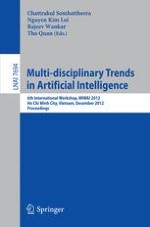2012 | Book
Multi-disciplinary Trends in Artificial Intelligence
6th International Workshop, MIWAI 2012, Ho Chi Minh City, Vietnam, December 26-28, 2012. Proceedings
Editors: Chattrakul Sombattheera, Nguyen Kim Loi, Rajeev Wankar, Tho Quan
Publisher: Springer Berlin Heidelberg
Book Series : Lecture Notes in Computer Science
